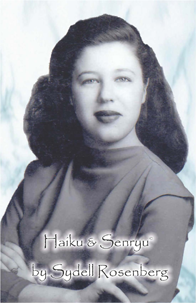When I put out a call for contributions to my summer reading program, I received a wonderful email from a woman who wanted to share her mother’s love of Haiku poetry (a Japanese poem of seventeen syllables, in three lines of five, seven, and five). Amy’s late mother, Sydell Rosenberg, was a school teacher in New York City. She was also a gift, published Haiku poetry writer and charter member of the Haiku Society of America, founded in 1968. After Sydell passed on, Amy’s husband put together a booklet to share her beautiful Haiku poetry with the world. Her works can be found on SydellPoetry.com.

Sydell’s daughter is now working with two organization to help promote creativity in children, another passion of mine! I really do think that creativity and literacy go hand in hand. Inspiring a child to look at the world in a new way leads to the creation of poetry, fiction and even non-fiction! Children naturally have vivid imaginations and are eager to share their unique, fascinating perspectives with everyone around them. By encouraging a love of poetry, it opens up new realms of self-expression.
Promoting Literacy and Creativity through Sydell’s Poetry
The two organizations that Amy is working with to carry on her mother’s passion are Arts for All and the Children’s Museum of the Arts. Amy did a great job of describing the mission of both programs, so I’ll let her words explain them:
Arts For All‘s programs include Literacy Through the Arts to build reading and phonics skills for students in grades K-2 at Hamilton Heights School and PS 15 (both in Manhattan); an annual Audience Project tour that brings free professional performances to students in all 5 boroughs of NYC; Step Right Up! helping students write, produce, and perform an original show; Creative Works for youth living with disability and illness at New Alternatives for Children; and the new Sydell Rosenberg Haiku Program in the fall of 2013 that will merge poetry and visual arts at PS 163 in the Bronx. Arts For All also runs many ongoing artistic residencies and workshops throughout the 5 boroughs.
Founded in Lower Manhattan in 1988, the Children’s Museum of the Arts provides authentic hands-on art experiences for children with practicing artists, both in an art-filled museum and in the community. CMA’s mission is to extend the benefits of the arts to all children and their communities and to secure the future of the arts by inspiring and championing the next generation of artists and art lovers. CMA works to fulfill its mission through four distinct initiatives: On-Site Public Programming that includes interactive art stations and artist-led workshops, early-childhood arts workshops, after-school classes, intensive art camps and special family programs; School & Community Outreach Programs throughout New York City; Art Exhibitions; and a Permanent Collection of 2,000 pieces of children’s art from around the world.
CMA is creating its own PoeTree: building a large scale tree out of braided fabric, foam, paper, and string. Once this original PoeTree project is completed, children will find inspiration and guidance from the gorgeous haikus of my mom and learn the fundamentals of haiku writing. Inspired by these imagery-laden short works, children will leave their mark at CMA by writing their own haikus on paper leaves and hanging them on the PoeTree!
Learn more about Haiku and Sydell
If you would like to learn more about Sydell and her beautiful Haiku poetry, be sure to visit the website and download the free booklet! The Haiku poems in the booklet are quite beautiful. I have never been a good poet, but I do appreciate the beauty that others can create with just a few words. That is perhaps the most amazing thing about haiku poetry- you have so few syllables to paint a vivid picture for the reader. I think it really is one of the most complex yet stunning forms of poetry.



I have never been a huge fan of poetry and I find it hard to understand. I do realize the importance of reading this type of art and I want my own children to enjoy it.